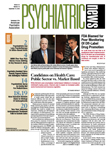A type of rare and spontaneous mutation that affects specific chromosomes has been linked to a substantial portion of schizophrenia cases and provides clues for the disease pathogenesis, as shown in several recent studies.
Copy-number variations (CNVs) refer to a type of genetic mutation in which chunks of DNA are repeated for a different number of times in a chromosome in different persons. The repeated DNA segments can range in size from thousands to millions of base pairs, may contain a gene or part of a gene, or disrupt a gene located in a chromosome, thus resulting in variations in the number of copies and the function of certain genes.
In two studies published in the July 30 Nature online, two groups of researchers separately found associations between the risk of psychotic disorders and rare CNVs. Deletions of substantial chunks of DNA at certain locations on the chromosomes were more common in individuals with schizophrenia or other psychoses than in healthy controls, the studies showed.
A number of studies have been published within the past few years that began to unravel the complex genetic patterns of mental illness, including but not limited to schizophrenia. Scientists have accumulated much evidence to suggest an important role of genetic predisposition in schizophrenia; however, unlike sickle-cell anemia or Huntington's disease, schizophrenia has a far more complex hereditary pattern and seems to involve a huge number of vulnerable mutations.
The latest findings suggest that rather than a few common hereditary mutations that render several genes vulnerable to disease, the genetic damages may occur “de novo” (spontaneously) at many places throughout the genome and are not inherited from either parent.
In one study, Hreinn Stefansson, Ph.D., at deCODE Genetics, Iceland, and a large group of multinational collaborators found that de novo chromosomal deletions at three loci were significantly associated with schizophrenia and other psychoses. The deletions are found at one locus on chromosome 1 (1q21.1) and at two loci on chromosome 15 (15q11.2 and 15q13.3), respectively. Two of these deletions have high odds ratios of greater than 11 in association with schizophrenia; the other had an odds ratio of greater than 2.
The authors compared genomic data from a multinational sample of 4,571 patients with schizophrenia, schizoaffective disorder, or other psychosis diagnoses with data from 33,000 controls.
Another study, conducted by the International Schizophrenia Consortium, identified associations between schizophrenia and microdeletions at three loci: 22q11.2, 15q13.3, and 1q21.
Patients with schizophrenia have significantly more CNVs in general throughout their genomes than healthy controls, the study showed. The findings add support to the theory that vulnerability for schizophrenia, at least in part, emerges from CNVs on multiple chromosomes, each of which is rare but here collectively significant. The study authors, from Europe and the United States, collaborated on a genome-wide survey of 3,391 patients with schizophrenia and 3,181 healthy controls with matched ancestry.
Both studies were particularly informative because of the large sample sizes, thanks to the multinational collaborations. They allowed researchers to detect the rare CNVs that exist more frequently in schizophrenia patients. With thousands of individuals' DNA samples, the researchers were able to pick up differences in rare CNVs that would otherwise have been impossible to detect.
“Identified CNVs [associated] with schizophrenia may point the way toward underlying pathogenic pathways in the disease,” Stephansson and colleagues commented. They suggested that additional CNVs associated with abnormal neurodevelopment may be identified in further genomic scans, and these CNVs may not necessarily manifest as the phenotype of classic schizophrenia. For example, CNVs have been identified in autism and mental retardation as well as schizophrenia.
In an earlier study, published in the May 30 online Nature Genetics, Columbia University researcher Bin Xu, Ph.D., and colleagues also found significant association of rare de novo CNVs with the sporadic type of schizophrenia (no history of the disease in a first- or second-degree relatives) but not with the familial type.
Their study included 152 individuals with the sporadic type of schizophrenia or schizoaffective disorder, 159 control subjects without either disorder, and 48 with familial schizophrenia or schizoaffective disorder. All participants were recruited from a genetically homogeneous Afrikaner population in South Africa to minimize the mutational “noise” in their genetic background.
The frequency of de novo CNVs found by these researchers was approximately 10 percent in sporadic schizophrenia patients, significantly higher than the 1.3 percent seen in unaffected controls. Deletions in the 22q11.2 locus were again identified in three subjects, all of whom had schizophrenia.
Discoveries regarding CNVs in the past few years have cast light on chromosomal mutations in neuropsychiatric disorders that could have been detected by conventional genetic research. Schizophrenia, autism, and mental retardation have so far been linked to CNVs, especially DNA deletions at the locus 22q11.2 (Psychiatric News, May 2). This suggests that“ deletions [at this locus] produce a range of clinically heterogeneous phenotypes,” noted the International Schizophrenia Consortium. These discoveries will challenge the conventional classification of schizophrenia, currently based merely on symptomatic clustering, and provide a finer picture of specific genotypes and phenotypes.
An abstract of “Strong Association of De Novo Copy Number Mutations With Sporadic Schizophrenia” is posted at<www.nature.com/ng/journal/v40/n7/abs/ng.162.html>. An abstract of “Large Recurrent Microdeletions Associated With Schizophrenia” is posted at<www.nature.com/nature/journal/vaop/ncurrent/abs/nature07229.html>. An abstract of “Rare Chromosomal Deletions and Duplications Increase the Risk of Schizophrenia” is posted at<www.nature.com/nature/journal/vaop/ncurrent/abs/nature07239.html>.▪
